A longsword is a type of European sword characterized as having a cruciform hilt with a grip for two-handed use, a straight double-edged blade of around 85 to 110 cm, and weighing approximately 1 to 1.5 kg.

Plate armour is a historical type of personal body armour made from bronze, iron or steel plates, culminating in the iconic suit of armour entirely encasing the wearer. While there are early predecessors such as the Roman-era lorica segmentata, full plate armour developed in Europe during the Late Middle Ages, especially in the context of the Hundred Years' War, from the coat of plates worn over mail suits during the 14th century.

The sallet was a combat helmet that replaced the bascinet in Italy, western and northern Europe and Hungary during the mid-15th century. In Italy, France and England the armet helmet was also popular, but in Germany the sallet became almost universal.

The bascinet – also bassinet, basinet, or bazineto – was a Medieval European open-faced military helmet. It evolved from a type of iron or steel skullcap, but had a more pointed apex to the skull, and it extended downwards at the rear and sides to afford protection for the neck. A mail curtain was usually attached to the lower edge of the helmet to protect the throat, neck and shoulders. A visor was often employed from ca. 1330 to protect the exposed face. Early in the fifteenth century, the camail began to be replaced by a plate metal gorget, giving rise to the so-called "great bascinet".

A greave or jambeau is a piece of armour that protects the leg.
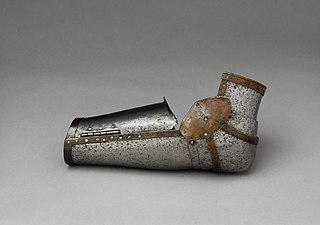
Vambraces or forearm guards are tubular or gutter defences for the forearm worn as part of a suit of plate armour that were often connected to gauntlets. Vambraces may be worn with or without separate couters in a full suit of medieval armour. The term originates in the early 14th century. They were made from either boiled leather or steel. Leather vambraces were sometimes reinforced with longitudinal strips of hardened hide or metal, creating splinted armour.

The armet is a type of helmet which was developed in the 15th century. It was extensively used in Italy, France, England, the Low Countries and Spain. It was distinguished by being the first helmet of its era to completely enclose the head while being compact and light enough to move with the wearer. Its use was essentially restricted to the fully armoured man-at-arms.
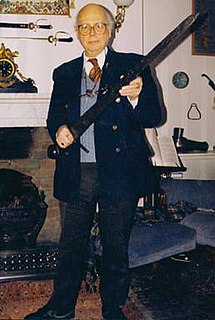
Ewart Oakeshott was a British illustrator, collector, and amateur historian who wrote prodigiously on medieval arms and armour. He was a Fellow of the Society of Antiquaries, a Founder Member of the Arms and Armour Society, and the Founder of the Oakeshott Institute. He created a classification system of the medieval sword, the Oakeshott typology, a systematic organization of medieval weaponry.
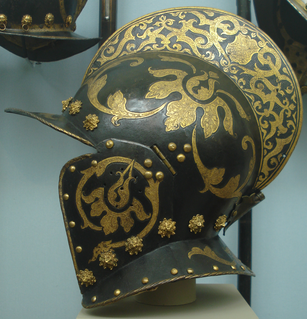
The burgonet helmet was a Renaissance-era and early modern combat helmet. It was the successor of the sallet.

The lobster-tailed pot helmet, also known as the zischägge, horseman's pot and harquebusier's pot, was a type of post-Renaissance combat helmet. It became popular in Europe, especially for cavalry and officers, from c. 1600; it was derived from an Ottoman Turkish helmet type. The helmet gradually fell out of use in most of Europe in the late 17th century; however, the Austrian heavy cavalry retained it for some campaigns as late as the 1780s.

Schynbalds were an early experiment in plate armour for the lower leg. Schynbalds were metal plates strapped over chausses. Each schynbald was a single piece of steel that covered the front and outside of the shin. Schynbalds did not enclose the lower leg: hence, they were not true greaves. Schynbalds first appeared in the 1230s or 1250s and remained in use during the fourteenth and fifteenth centuries.
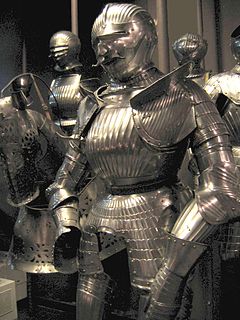
Maximilian armour is a modern term applied to the style of early 16th-century German plate armour associated with, and possibly first made for the Emperor Maximilian I. The armour is still white armour, made in plain steel, but it is decorated with many flutings that may also have played a role in deflecting the points and blades of assailants and increasing the structural strength of the plates. It is a transitional stage in the decoration of armour, after the plain steel surfaces of 15th-century armour and before the elaborate decoration and colouring with etching and other techniques of Renaissance armour. The armour is characterized by armets and close helmets with bellows visors; small fan-shaped narrow and parallel fluting—often covering most of the harness ; etching; work taken from woodcuts; sharply waisted cuirasses, and squared sabatons.

A bevor or beaver is a piece of plate armour designed to protect the neck, much like a gorget.
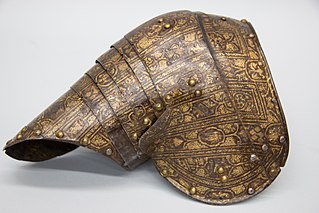
A rerebrace is a piece of armour designed to protect the upper arms. Splint rerebraces were a feature of Byzantine armour in the Early Medieval period. The rerebrace seems to have re-emerged in England, in the early 14th century. As part of the full plate armour of the Late Middle Ages and Renaissance the rerebrace was a tubular piece of armour between the shoulder defences and the elbow protection (couter).

Splint armour is armour consisting of strips of metal ("splints") attached to a cloth or leather backing. It is most commonly found as limb armour such as greaves or vambraces.
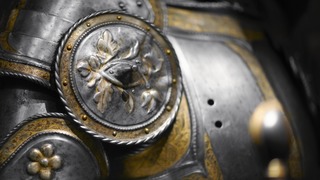
A rondel is a circular piece of metal used for protection, as part of a harness of plate armour, or attached to a helmet, breastplate, couter or on a gauntlet.
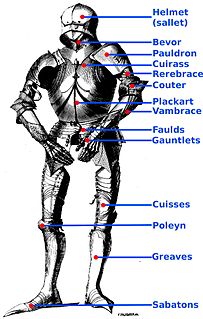
This table identifies various pieces of body armour worn from the medieval to early modern period in the Western world, mostly plate but some mail armour, arranged by the part of body that is protected and roughly by date. No attempt has been made to identify fastening components or various appendages such as lance rests or plumeholders or clothing such as tabards or surcoats which were often worn over a harness. The slot in the helmet is called an occularium.
Gothic plate armour was the type of steel plate armour made in the Holy Roman Empire during the 15th century.
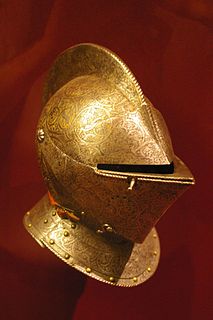
The close helmet or close helm was a military helmet worn by knights and other men-at-arms in the Late Medieval and Renaissance eras. It was also used by some heavily armoured, pistol-armed, cuirassiers into the mid 17th century. It was a fully enclosing helmet with a pivoting visor and integral bevor.
Transitional armour describes the armour used in Europe around the 14th century, as body armour moved from simple mail hauberks to full plate.


















